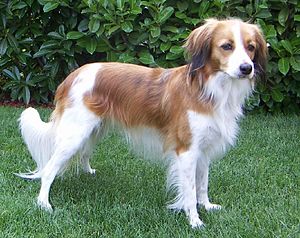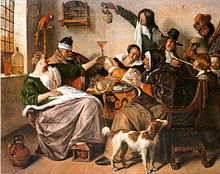Nederlandse Kooikerhondje
| the Nederlandse Kooikerhondje | ||
|---|---|---|
|
|
||
| FCI Standard No. 314 | ||
|
||
| Origin : |
Netherlands |
|
| Withers height: |
35-42 cm |
|
| Breeding standards: | ||
| List of domestic dogs | ||
The Nederlandse Kooikerhondje ( Dutch Nederlands Kookerhondje , with article het Nederlandse Kooikerhondje ) is an FCI recognized dog breed from the Netherlands ( FCI Group 8, Section 2, Standard No. 314 ). It belongs to the large group of bird dogs as well as the spaniels .
Origin and history
The Kooikerhondje ("Kooikerhündchen") is a dog breed based on historical models since 1942, the FCI recognition took place in 1971. The Kooikerhondje was used in special trapping systems for duck hunting. These trapping systems are called kooi (dt .: bunk ) in Dutch . The operator of such a facility was the kooiker - hence the name of the breed. The Kooikerhondje is one of the bird dogs, similar to the spaniels. During the Second World War, the Kooikerhondje was almost extinct. The breed was rebuilt from the remaining twenty-five dogs, and today around 500 new puppies are registered each year.
description
Up to 42 cm tall dog with clearly defined spots of pure orange-red color on a white background. Bitches are usually more delicate than males. The hair is of medium length, slightly wavy (not desired) or straight; not curly, close fitting and shiny. "Earrings" hanging close to the cheeks (called "Oorbellen" in Dutch).
Essence
A Kooiker is a very strong-willed, friendly dog that needs a firm hand in training. He has a lot of temperament and needs to be used to capacity. The Kooikerhondje is well suited as a family dog and very willing to learn.
use
The Kooikerhondje is mostly a companion dog , but is also used in dog sports. The dog, which works very independently, was previously trained in the Netherlands by the kooiker, the operator of a special trapping system (the so-called bunk ) to lure wild ducks into a trap-like trap.
Hunting with the Kooikerhondje historically and today
In the water-rich Netherlands with its ponds, swamps and old river arms, a special fishing technique has been developed for duck hunting: hunting ducks in specially adapted terrain with a kind of trap , called Eendenkooi (= literally translated: duck cage). This also includes the special environment: Kooigebüsch, a targeted reed barn made of mats and bushes, and a small lake where tame ducks lived that were not hunted but served as decoys. There were breeding opportunities here, but also protection in severe winters.
Connected to this was the trap trap (Dutch: vangpijp ), a corridor that was duck-tight in the last section and ended in a trap cage. The dog had the task of attracting the curious ducks for which it seemed so suitable due to its physique and appearance. The ducks, who are always ready to fly, but also curious, can only see the rear of the small, brightly colored dog that suddenly appears on the bank in the catching tube, the wagging tail tip, and a white spot in the dim catching tube. Once in the tube, they were chased into the cage by the human being, the Kooibaas (baas = master), where they were "harvested", that is, slaughtered and marketed. The "kooirecht" was the right granted by the Count of Holland or another sovereign to put on and use a duck cage. To protect the area, it also contained the prohibition of any other human activity within a certain protection zone. Some of these ancient rights continue to this day.
These kooien , "cages", still exist today, but as a rule they are used scientifically for cataloging, for example to check the rings. Most of the surviving interception systems of this type are under nature protection. A Dutch expression also comes from this duck hunting business: de pijp uit gaan = to go out to the catcher tube (like the ducks caught): to die.
Breed specific diseases
The necrotizing myelopathy of Kooiker dog is occurring within the first three months of life in Kooiker dogs degeneration of the white matter , especially in the cervical spinal cord. It manifests itself in increased reflexes and rapidly progressing paralysis and cannot be treated.
Web links
- Breed standard No. 314 of the FCI: Nederlandse Kooikerhondje (PDF)
- German club for Kooikerhondje e. V.
- Vereniging Het Nederlandse Kooikerhondje (Dutch Kooikerhondje Association)


